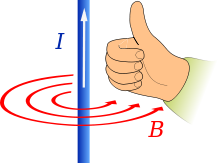Right-hand rule

In mathematics and physics, the right-hand rule is a common mnemonic for understanding notation conventions for vectors in 3 dimensions. It was invented for use in electromagnetism by British physicist John Ambrose Fleming in the late 19th century.[1][2]
When choosing three vectors that must be at right angles to each other, there are two distinct solutions. This can be seen by holding your hands together, palm up, with the fingers curled. If the curl of your fingers represents a rotation from the first axis to the second, then the third axis can point either along your right thumb or your left thumb.
There are variations on the mnemonic depending on context, but all variations are related to the one idea of choosing a convention.
Right-handed rule for Cartesian coordinates
The right-hand rule in relation to a three dimensional coordinate axis system is described as follows. The thumb is orientated along the Z-Axis, the first or index finger is orientated to the X-Axis, and the second finger is orientated to the Y-Axis. The finger-tips of the three digits denote the positive direction of a linear translation or displacement. A positive rotation of the Z-Axis, anti-clockwise, is indicated by the third and fourth fingers. Positive rotations of the X and Y-Axis are also anti-clockwise.
The Cartesian axis system may be assigned X, Y, and Z; this will often be used to describe a global coordinate system. A local coordinate system may be described as: X’, Y’ and Z’ or 1, 2, and 3.
Right-hand rule for cross products
The cross product of two vectors is often encountered in physics and engineering. For example, in statics and dynamics, torque is the cross product of lever length and force, and angular momentum is the cross product of linear momentum and distance from an origin. In electricity and magnetism, the force exerted on a moving charged particle when moving in a magnetic field B is given by:
Magnetic force on a moving charged particle
The direction of the cross product may be found by application of the right hand rule as follows: Using your right hand,
- Point your index finger in the direction of the first vector A.
- Point your middle finger in the direction of the second vector B.
- Your thumb will point in the direction of the cross product C.
For example, for a positively-charged particle moving to the North, in a region where the magnetic field points West, the resultant force will point up.[3]
Direction associated with a rotation


A different form of the right-hand rule, sometimes called the right-hand grip rule or the corkscrew-rule, is used either when a vector (such as the Euler vector) must be defined to represent the rotation of a body, a magnetic field or a fluid, or vice versa when it is necessary to decode the rotation vector, to understand how the corresponding rotation occurs.
This version of the rule is used in two complementary applications of Ampère's circuital law:
- An electric current passes through a solenoid, resulting in a magnetic field. When you wrap your right hand around the solenoid with your fingers in the direction of the conventional current, your thumb points in the direction of the magnetic north pole.
- An electric current passes through a straight wire. Here, the thumb points in the direction of the conventional current (from positive to negative), and the fingers point in the direction of the magnetic lines of flux.
The rule is also used to determine the direction of the torque vector. If you grip the imaginary axis of rotation of the rotational force so that your fingers point in the direction of the force, then the extended thumb points in the direction of the torque vector.
The right-hand rule is just a convention. When applying the rule to current in a straight wire for example, the direction of the magnetic field (counterclockwise instead of clockwise when viewed from the tip of the thumb) is a result of this convention and not an underlying physical phenomenon.
Applications
The first form of the rule is used to determine the direction of the cross product of two vectors. This leads to widespread use in physics, wherever the cross product occurs. A list of physical quantities whose directions are related by the right-hand rule is given below. (Some of these are related only indirectly to cross products, and use the second form.)
- For a rotating object, if the right-hand fingers follow the curve of a point on the object, then the thumb points along the axis of rotation in the direction of the angular velocity vector
- A torque, the force that causes it, and the position of the point of application of the force
- A magnetic field, the position of the point where it is determined, and the electric current (or change in electric flux) that causes it
- A magnetic field in a coil of wire and the electric current in the wire
- The force of a magnetic field on a charged particle, the magnetic field itself, and the velocity of the object
- The vorticity at any point in the field of flow of a fluid
- The induced current from motion in a magnetic field (known as Fleming's right-hand rule)
- The x, y and z unit vectors in a Cartesian coordinate system can be chosen to follow the right-hand rule. Right-handed coordinate systems are often used in rigid body physics and kinematics.
Coordinate orientation
| Axis or vector | Right-hand | Right-hand (alternative) |
|---|---|---|
| X, 1, or A | First or index | Thumb |
| Y, 2, or B | Second finger or palm | First or index |
| Z, 3, or C | Thumb | Second finger or palm |
See also
- Chirality (mathematics)
- Curl (mathematics)
- Fleming's left-hand rule for motors
- Improper rotation
- ISO 2
- Pseudovector
- Reflection (mathematics)
- Vorticity
References
- ^ Fleming, John Ambrose (1902). Magnets and Electric Currents, 2nd Edition. London: E.& F. N. Spon. pp. 173–174.
{{cite book}}: Cite has empty unknown parameter:|coauthors=(help) - ^ "Right and left hand rules". Tutorials, Magnet Lab U. National High Magnetic Field Laboratory. Retrieved 2008-04-30.
- ^ PHYS345 Introduction to the Right Hand Rule, George Watson, University of Delaware, 1998
- ^ http://www.physics.udel.edu/~watson/phys345/Fall1998/class/1-right-hand-rule.html
- ^ http://www.manufacturinget.org/home/4476-computer-aided-manufacturing/fundamentals-of-g-code-programming/
External links
- Right and Left Hand Rules - Interactive Java Tutorial National High Magnetic Field Laboratory
- A demonstration of the right-hand rule at physics.syr.edu
- Weisstein, Eric W. "Right-hand rule". MathWorld.
- Dr. Johannes Heidenhain : Right Hand Rule - Heidenhain TNC Training : heidenhain.de
- Christian Moser : right-hand-rule : wpftutorial.net

